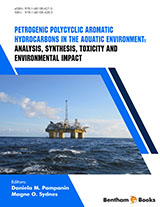Abstract
The carcinogenicity associated with PAH contamination in the aquatic environment has been a topic of prime importance since neoplasia was described in fish living in multi-sources contaminated areas, 50 years ago. Since then, a whole array of studies were conducted in order to better characterize the fate of PAHs, their bioavailability for biota and their effects in term of neoplastic lesions. Genotoxicity assessment is at the heart of the matter, as benzo[a]pyrene, the leader of PAHs, is described as ubiquitous genotoxic and carcinogenic compound, acting in particular by the occurrence of reactive diol metabolite that forms DNA adducts. The causal relationship between exposure to PAHs and occurrence of neoplasia in organisms involves to explore the biological plausibility of the association. Biomarkers of genotoxicity/mutagenicity are a central part of tools that measure the biological plausibility. DNA adducts and DNA strand breaks are lesions that can be advantageously used in sentinel organisms.
Keywords: DNA, DNA adducts, Genotoxicity, Neoplasia, Polycyclic aromatic hydrocarbons (PAHs).












